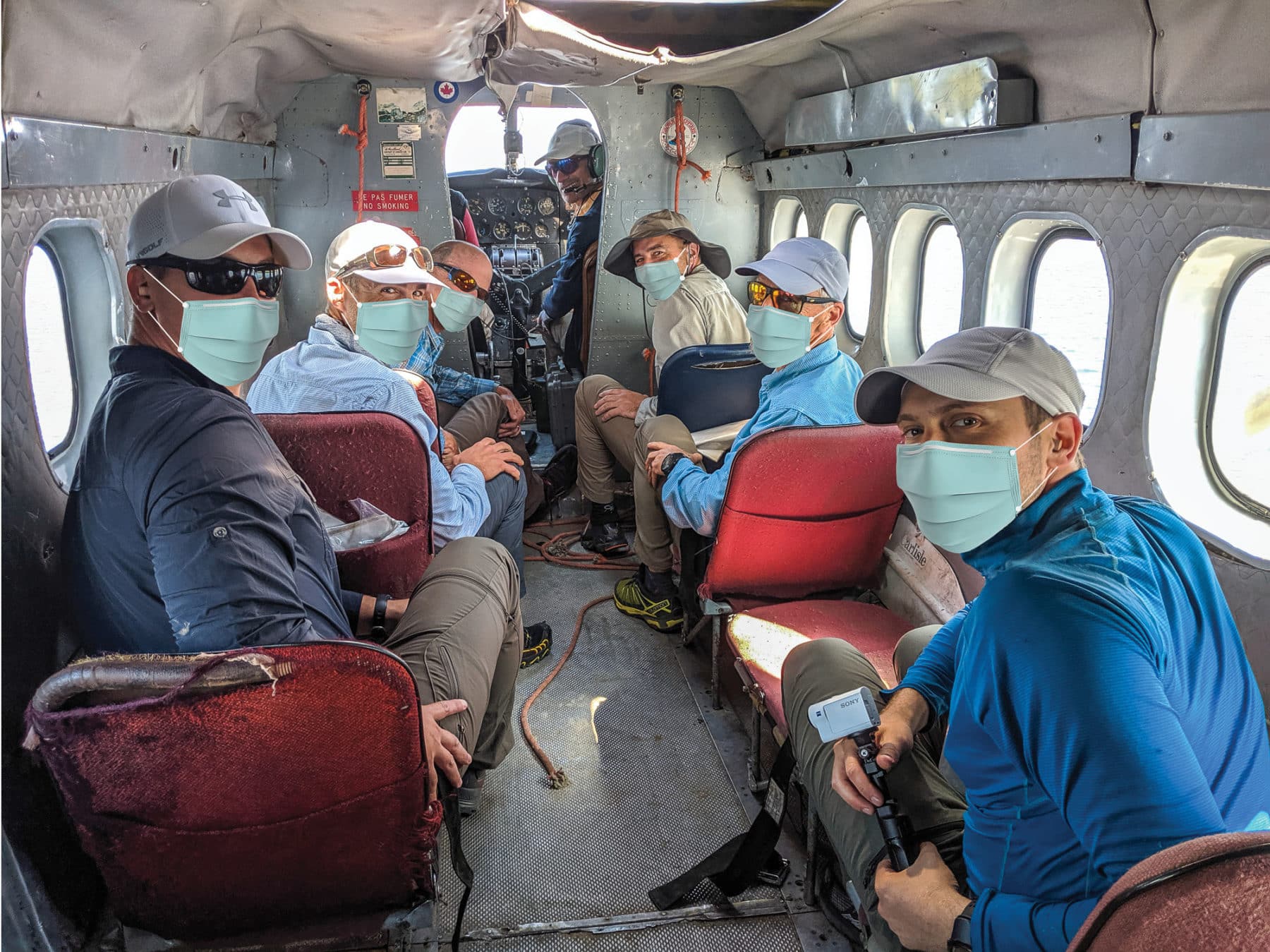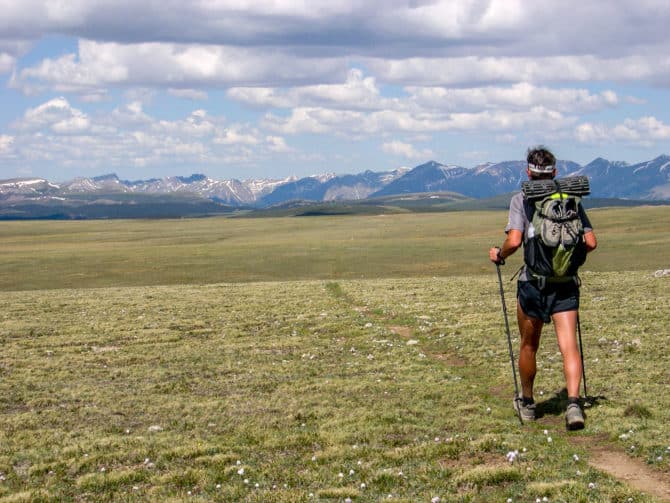The novel coronavirus has upended life as we once knew it. With therapeutic treatments and vaccines, we’ll revert to our old normal eventually, but in the meantime we’ll have to learn to live with it — How can we still work and play without compromising our own safety or that of our family, friends and neighbors?
As an avid backpacker and the owner of a backpacking guide service, I’m particularly motivated to develop and adopt backcountry best practices for this coronavirus era. A fact-based set of policies and protocols can help to reduce risk, minimize unfounded fears, and perhaps even encourage land managers to lift restrictions.
This four-part series is motivated by my guided trip program, but it has significant relevance to the broader backpacking and outdoor communities. Some of it was directly influenced by reader feedback to a very popular post from last month, “When & how will backpacking be safe and feasible again?”

Approach, and table of contents
Backcountry travel — and life, more generally — has never been risk-free. In an ordinary season, I will encounter swift water, lightning, grizzly bears, steep snowfields, cold soaking rain, and shifting talus, among other variables that are inherently not safe, oftentimes while leading a group of clients.
That may sound like chest-beating, but I point this out because I’m approaching Covid-19 the same way that I address every other risk:
- Understand it, and
- Take steps to mitigate it.
Part 1 is dedicated to the understanding of Covid-19. It’s an objective assessment of this new risk based on what is known and not yet know.
Part 2 describes specific behaviors and policies that my guiding program will implement for 2020 in order to reduce our Covid-19 risk.
After understanding a backcountry risk and identifying mitigation tactics, typically the choice of whether and how to proceed is left with the individual. In the case of Covid-19, however, broader public safety concerns have resulted in layers of restrictions. In Part 3, I highlight the ten criteria that I’ll consider in making go/no-go decisions about my trips.
Executive summary
Part 1: The Facts
Covid-19 is a highly contagious respiratory disease. Common symptoms include coughing, shortness of breath, and fever, among others.
Older populations (65+) and those with certain underlying health issues (e.g. obesity, diabetes, lung or heart disease) are at substantially greater risk of hospitalization and death due to Covid-19. No surefire treatments exist at this time.
Covid-19 is thought to spread through respiratory droplets when an infected person talks, coughs, sneezes, or even breathes. Most cases have been associated with close and prolonged exposure to an infected person in a confined area, such as a house, care facility, or restaurant.
Part 2: New normal
From trailhead to trailhead, backcountry users are at low-risk, especially if precautions are taken. Maintain distance (6+ feet) between people, and wear face coverings when that’s not possible. And be sensitive to the risk of contaminated surfaces by washing hands and not sharing gear or supplies.
The most high-risk part of backcountry travel is probably getting to the location, especially if it entails public transportation. The factors that make backcountry travel low-risk (ventilation, space, small groups, self-sufficiency) are the same factors that make travel high-risk (limited airflow, tight quarters, more contact, and more shared surfaces).
Part 3: The restrictions
Restrictions have been placed on outdoor recreation and broader travel to help minimize the spread of Covid-19. To assure that a trip is not illegal, impractical, or simply ill-advised, consider:
- Stay-at-home orders
- Travel options
- Quarantines for non-locals
- Public land closures
- Medical capacity
- Guidance from gateway communities and rescue teams
- Availability of trip supplies
- Bailout/self-rescue options

Why am I sharing this here?
I have not before shared core program resources, like our emergency protocols or operations plan. But posting these best practices online has multiple advantages:
1. Clients and land agencies rightfully want to know how we are handling this risk. I can easily point them here, where I can keep our policies current as we learn more about the virus.
2. Organizations large and small are trying to figure this out, and I certainly don’t have all the answers. In this case, more heads is better than one, and I’m hoping that public feedback can lead to marginal improvements.
3. Covid-19 has been a monkey wrench for many organizations, including mine. Perhaps I can help save time and improve program safety for a hiking club, Scout troop, or less established guide service.
Disclaimers
1. The extent of my medical training an 80-hour wilderness first responder course plus biannual 24-hour re-certifications. So don’t put stock in my medical advice, though I think you’ll find the content to be consistent with the opinions of medical experts.
2. Our understanding of COVID-19 is rapidly changing, and I expect to update my policies and recommendations accordingly. These pages should be accurate as of the most recent publishing date.
“Covid-19 is thought to spread through respiratory droplets when an infected person talks, coughs, sneezes, or even breathes.”
I’m not a doctor. But I have a relative who is doctor and works in a hospital setting. He has been in that setting for more than 20 years. I found the following information helpful for myself and my immediate family. But if it were for a business I might go further in getting additional sources to verify. He told me that the main transmission vector is surface contact. An infected person has virus on their hands, they touch a surface, I touch the surface, I touch my eyes, nose, or mouth, and I get infected. He said that breathing produces very small droplets that can contain the virus, and the droplets are small enough they don’t get taken to the ground by gravity very quickly. So they can carry farther – like the 27 feet you could see on those videos in the news. But the amount is so small that you will not get infected. Probably a better way to say it is the likelihood is so low that we don’t need to worry about it. Maybe it is like carrying bear spray in state parks in Texas – just way overkill. He said only a few diseases carry risk of transmission in this way (TB was one?). However, when a person coughs or sneezes they produce droplets that contain enough virus that transmission can occur. But now gravity works in our favor. They are big enough that they won’t go beyond about six feet. Don’t know how long before they hit the ground. But if we are nearby and someone sneezes without covering up, we can see it and avoid. And unless you have an N95 mask, you can’t effectively protect yourself anyways if you walk into that cloud of sneeze (don’t know what else to call it). To further emphasize this point, he told me that the guidance that they have at their hospital from the CDC, and what he has been doing for some time now, is that they only have to use N95 masks in a few operations, like intubating a patient because of the droplets that get produced. The rest of the time he only wears the less protective style mask like we non-medical people have used in stores. He also pointed out that wearing that type of mask only protects others if you are coughing or sneezing and it stops the droplets, and at this point, most people are not coughing unprotected. I asked him why should we bother wearing a mask then. He said the main benefit in his opinion now is that it reminds us not to touch our face. So when we go into a setting where presence of the virus is more likely on surfaces, like a store, then it can stop us from touching our face since we are not in the habit of avoiding that.
Sorry for the long post but didn’t know how to get all that across. I’m not sure why this is not talked about more broadly. Or maybe it is and I just don’t know it because I have restricted my daily intake of news 🙂
My quick thought on a group backpacking trip is this. I think I would ask everyone to wear a mask where there are high risk surface, like the airport, plane, and ground transportation to the trail head. This would reduce our chances as a group of one of us inadvertently picking it up on the way to the trailhead. But after that I would not wear them and just make an agreement to cover up if coughing or sneezing, maybe not share gear like you are thinking, and help each other get in a habit of not touching your face or eating without first cleaning hands. Most people wash their hands before eating but I have to admit I don’t do that before eating snacks while on the move. Not sure how much 6′ social distancing will take away from the trip experience. If not much then maybe that is the simple thing. Just do that. But if it is going to seriously detract from the experience, it might be worth looking further into whether 6′ is really necessary if the group avoids coughing and sneezing unprotected.
Just saw your next post on the objective risk of Covid-19. Probably should have read that first since you are touching on some of the same topics… 🙂
Appreciate Todd’s thoughtful post and agree.